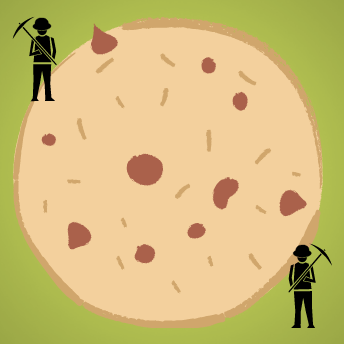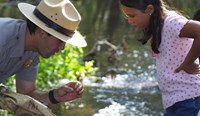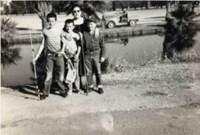- Lesson Plan (94)
- Distance Learning (20)
- Field Trips (16)
- Student Activities (7)
- Traveling Trunk (7)
- Guest Speakers (1)
- Media for Loan (1)
- Online Galleries (1)
- Other Education Materials (1)
- Teacher Reference Materials (1)
- Homestead National Historical Park (6)
- Acadia National Park (5)
- Arches National Park (5)
- Bent's Old Fort National Historic Site (4)
- George Washington Carver National Monument (4)
- Glacier National Park (4)
- Kenai Fjords National Park (4)
- National Park of American Samoa (4)
- Olympic National Park (4)
- Show More ...
- Science (87)
- Social Studies (82)
- Literacy and Language Arts (40)
- Math (7)
Showing 147 results for soil conservation ...
Cookie Conservation
- Type: Lesson Plan
- Grade Levels: Upper Elementary: Third Grade through Fifth Grade

Students will mine chocolate chips out of chocolate chip cookies as a proxy for fossil collecting. The point of this activity is to get students to think about how fossil collecting can make a public land site much less appealing to visit and eventually leave no fossils for future generations to see.
Chocolate Chip Conservation
- Type: Student Activities
- Grade Levels: Upper Elementary: Third Grade through Fifth Grade
A delicious activity to teach kids about the importance of conservation.
Civilian Conservation Corps
- Type: Lesson Plan
- Grade Levels: Middle School: Sixth Grade through Eighth Grade
So You Wanna Be a Paleontologist?
- Type: Lesson Plan
- Grade Levels: Upper Elementary: Third Grade through Fifth Grade

Students will become familiarized with fossils that have been uncovered in Florissant Fossil Beds from the Eocene and Quaternary. They will select a certain extinct species and make a sketch on a Popsicle stick canvas. After shuffling their Popsicle stick fossil, they will then hide the sticks around a room and have someone else find and "excavate" the Popsicle stick fossil and attempt to put it back together. Best done with a partner to exchange fossils to find and put together.
So You Wanna Be a Paleobotanist?
- Type: Lesson Plan
- Grade Levels: Upper Elementary: Third Grade through Fifth Grade

Students will re-create scientific studies done by paleobotanists analyzing data from fossil plants found at Florissant Fossil Beds to draw conclusions about the paleoclimate 34 million years ago. In this activity, students will identify fossil plant species by their leaves, review data on the growing conditions of their nearest modern plant relatives, and compare as many species as possible to determine the range of temperature and precipitation that the fossil plant community can live in.
Conservation vs Preservation and the National Park Service
- Type: Lesson Plan
- Grade Levels: High School: Ninth Grade through Twelfth Grade
Discover the difference between conservation and preservation and learn how the National Park Service plays a role in each.
Company 818 and Segregation in the Civilian Conservation Corps
Freeing the Elwha (Aspect and Soil Moisture)
So you want to be an American President
- Type: Lesson Plan
- Grade Levels: Upper Elementary: Third Grade through Fifth Grade
Nature, Art and Conservation at Marsh-Billings-Rockefeller National Historical Park
- Type: Lesson Plan
- Grade Levels: High School: Ninth Grade through Twelfth Grade

Thomas Cole, the founder of the Hudson River School, stated “The ravages of the axe are daily increasing desecration by what is called improvement; which as yet generally destroys Nature’s beauty without substituting that of Art.” This unit, Nature, Art and Conservation at Marsh-Billings-Rockefeller National Historic Park, will explore this very issue through on-site visits, school based lessons and independent research. For this unit students will begin by reading Marsh’s Man and Nature...
"What's So Special?" Environment: 4-6 Grade
- Type: Lesson Plan
- Grade Levels: Upper Elementary: Third Grade through Fifth Grade

Students will draw a favorite plant, animal, or activity common to the Everglades environment and explain, in writing, the reason they chose it. This will help students recognize and identify one valuable aspect of a national park’s environment, and draw conclusions as to why they value that aspect of the environment.
George Washington Carver - An Original Conservationist: Sharing the Soil
- Type: Lesson Plan
- Grade Levels: High School: Ninth Grade through Twelfth Grade

For this activity students will create a brochure for farmers. The brochure will describe the needs each crop has (soil type, weather, etc.), the impact of the crop on the soil and the different ways the crop can be used. Students will focus on cotton, tobacco, peanuts, soybeans and sweet potatoes. The goal is for students to understand the impact cash crops may have on soil quality and how farmers can replenish their soil through crop rotation.
National Park Legacy - Battle the Bully Plants and Conserve Water! Grades 5 - 6
- Type: Lesson Plan
- Grade Levels: Upper Elementary: Third Grade through Fifth Grade

SMMNRA Nature Neighbor Project suggests native plant options for landscapes near natural areas. Native plants can generally resist weather challenges, require no fertilizer or pesticide and attract wildlife. Most importantly, plants native to Southern California are adapted to drought conditions and water is California’s most prized natural resource.
Scouts and Shovels: “Crashing the Gates” with Bertha Dutton
- Type: Lesson Plan
- Grade Levels: Middle School: Sixth Grade through Eighth Grade

Bertha Dutton was one of the first female archeologists who worked with the National Park Service. This lesson plan emphasizes her original methodologies and why her work was so important to both women’s history and cultural resource preservation. Este plan de clase con actividades incluido también está disponible en español.
George Washington Carver - An Original Conservationist: Alternative Uses for Everyday Materials
- Type: Lesson Plan
- Grade Levels: High School: Ninth Grade through Twelfth Grade

This topic is a focus on alternative uses for source materials and products that can be made with alternative materials. Students will make peanut milk in an effort to understand how foods can be used in different ways to increase nutrition to the consumer. Students will create a pros/cons poster researching products (such as fuel) and comparing traditional source materials (crude oil) with alternative materials (corn or soy-based ethanol).
"The Water Watch" Water: 4-6 Grade
- Type: Lesson Plan
- Grade Levels: Upper Elementary: Third Grade through Fifth Grade

The student will be able to: a) list two reasons why water conservation is necessary for the preservation of the Everglades, b) list two ways in which they can increase community involvement in water conservation, and c) produce a petition which lists ways to conserve water and get at least one hundred signatures on their petition.








